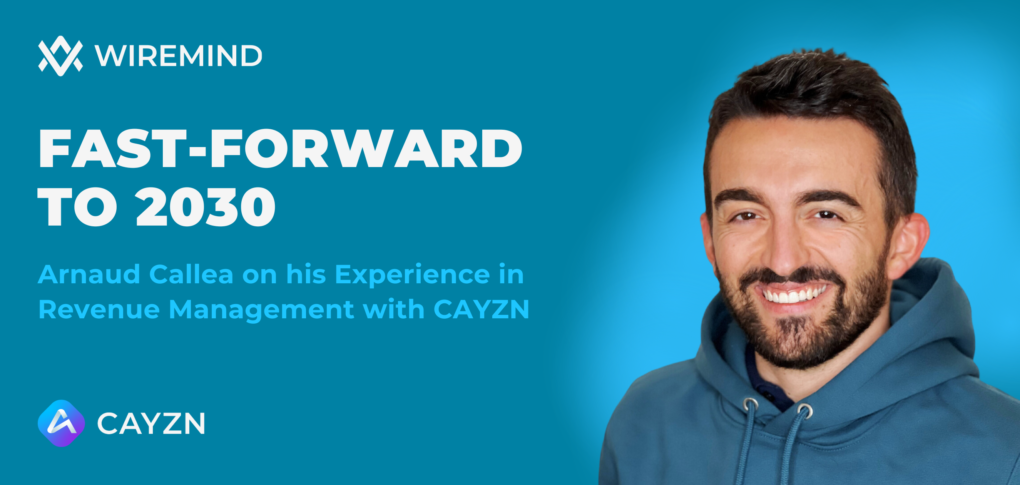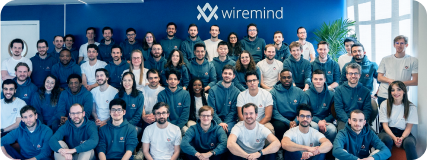Fast-Forward to 2030: Arnaud Callea on his Experience in Revenue Management with CAYZN

We sat down with our Lead Product Expert, Arnaud Callea, to discuss CAYZN and its potential to expand the horizons of Revenue Management in the passenger transportation industry.
Can you briefly explain your background and how you became an expert in CAYZN?
I am an optimization engineer specializing in complex systems. After obtaining my diploma, I joined Air France, which awarded me the honorary title of “Bébé Air France” given to those starting their career at the company. I began my professional journey as a Flight Analyst in the Revenue Management department.
I was first exposed to the world of Revenue Management (RM) during a previous internship at the company. As an intern in the Network Planning team, I assisted in determining which plane should be assigned to which destination. A crucial aspect of our business plans was the pricing strategy for each flight. The flight analysts, working on the floor below me, made these decisions on a daily basis.
Curiosity got the better of me, and in 2018, I gathered my courage and asked the flight analysts for a presentation. This was my first introduction to the world of RM, and I immediately fell in love with it. I haven’t looked back since!
I first heard about CAYZN from a friend, a former RM analyst. He insisted that I had to take a look at it. Soon enough, I found myself interviewing with Wiremind and exploring the application for the first time.
One aspect of CAYZN that truly captivated me was its potential. Although initially designed for the Rail industry, I immediately recognized that the existing workflow could be easily adapted to solve problems in the airline industry—problems I was facing at the time. It felt like I had suddenly woken up in 2030.
Following this realization, I adjusted my career path and joined Wiremind with the mission of helping CAYZN realize its full potential in the world of airlines.
For those unfamiliar, how would you define ‘revenue management’ in the context of transportation companies?
Revenue Management is the subtle art of charging the right price for the right service at the right time. Our mission is to ensure that every seat is sold while making a profit from the operation.
An ideal pricing strategy is never set in stone. What seems like the best strategy today may completely change tomorrow. Therefore, a good revenue manager must be reactive and able to easily access the right information to make informed decisions.
What makes CAYZN stand out from other Revenue Management tools on the market?
This one is easy. CAYZN was developed by former revenue managers for revenue managers. This tool addresses many unexpressed needs of revenue managers and is designed to help users achieve their goals efficiently.
In the current market, Revenue Management (RM) tools are designed based on a list of requirements provided by users. However, this doesn’t necessarily mean that the tool is user-friendly. Some aspects can only be understood by someone who has worked as a revenue manager. Our co-founders, Colin Girault-Matz and Charles Pierre, began developing CAYZN with a collection of great ideas that, while seemingly small individually, together make for an extremely user-friendly tool. It’s truly calming to see CAYZN at work!
Another aspect that sets CAYZN apart is our optimizer. Typically, in a Revenue Management System (RMS), the optimizer is a “black box.” Users are unable to understand how the optimized price is calculated; they are only given a suggestion to accept or reject. If they reject it, they must override it somehow, turning the black box into a black hole. Each override has ripple effects on other aspects of the optimizer, which also need to be overridden.
In contrast, CAYZN strives for full transparency. AI is not a magical tool that provides miraculous recommendations. Instead, it works collaboratively with the analyst, explaining how the optimizer thinks and how its decisions will impact the revenue management strategy. All of this is presented in a language that the analyst can comprehend.
How does CAYZN’s AI help in forecasting demand and optimizing pricing?
We provide statistical forecasts based on past history and current trends, which are usually highly accurate.
However, it’s important to be fully transparent about their reliability and accept that these forecasts may be inaccurate. The world is always evolving in unexpected ways, which will continuously impact demand differently from past data.
This information about statistical drift is highly valuable for analysts. It helps them understand and evaluate the accuracy of their pricing strategies. CAYZN AI is completely transparent with analysts, informing them if over-prediction or under-prediction has occurred. This information is presented alongside all the variables used to make the prediction, such as initially expected demand, competitor pricing, and trend factors.
Based on this information, analysts can raise appropriate alerts and take necessary actions. These actions can be highly automated, as users can decide the level of freedom they give CAYZN AI to change prices automatically or auto-correct forecast errors.
Alternatively, actions can involve human work, such as a new analysis of competition, new market research, or a deep dive into events that might have impacted demand.
If a decision from CAYZN AI is deemed inaccurate, its configuration can be modified to align with desired outcomes. For example, suppose a competitor was mistakenly followed in the past. In that case, the configuration can be adjusted to avoid such errors in the future, or it can be made conditional on other factors, like load factors or booking trends.
What I love about our solution is that it allows robots to do the robots’ work and humans to do the humans’ work.
Overall, our statistically probable forecasts provide analysts with a clear understanding of the algorithm’s thought process, enabling them to make informed decisions at every analysis level.
Given your expertise, what trends do you foresee in revenue management for transportation in the next five years?
In the next five years, the industry will shift towards what is referred to as “offer and order.” Currently, every airline wants to offer the cheapest flight to travel while also providing additional customization options for each customer. This means getting the right price and the right ancillary service for each customer.
Does that mean airlines can see travelers’ travel history?
It’s never like that. It’s more about customizing for each persona. A family of four will have different needs compared to four businesspeople traveling to a similar destination.
A family of four might add options like a kids’ meal, while business travelers might opt for Wi-Fi or a shower at the arrival airport. There are various ancillaries that can be offered to each persona, and these can be customized based on the scenario. Airlines are also moving towards competing on the prices of these ancillaries. This is something we’re already addressing with CAYZN Ancillary Management. This is the future of revenue management.
What would you say is an important KPI for Revenue Management for airlines?
Based on my experience in network planning, I would say that RASK (Revenue per Available Seat Kilometer) is one of the most important KPIs for airlines.
In networking, the crucial question is how much revenue can be generated per seat. When deciding which routes to assign to a plane, one must consider the trade-off between sending it on longer routes to maximize revenue (but incur higher costs) and opting for shorter routes that allow for more rotations at lower fares.
Ultimately, the key question is: which decision will lead to the most revenue generation? RASK helps answer this by measuring revenue generated per available seat kilometer.
However, those who have worked with me at Air France can attest to another key performance indicator that I highly value: the margin over variable costs. When demand is critically low, it is sometimes the best business decision to keep the plane grounded, as operating costs would exceed expected revenues. Canceling flights early is always a risky gamble for the company. With the forecast provided by CAYZN AI, this risk can be assessed with great precision, enabling informed decisions to be made in a timely manner.
What advice would you give transportation companies seeking to enhance their revenue management strategies?
Honestly? Ask for a demo of CAYZN!
Because to me, that’s the best advice I would give to anyone. If you want to improve your revenue, reach out to Wiremind.
Book a Demo
Why wait? Send an email to our product experts at [email protected] to schedule a personalized demo of CAYZN. See for yourself how it can revolutionize your revenue management processes.
Wait a sec! Interested in a quick demo?
Witness how Wiremind's optimization solutions can supercharge your operations.
Book a demo













